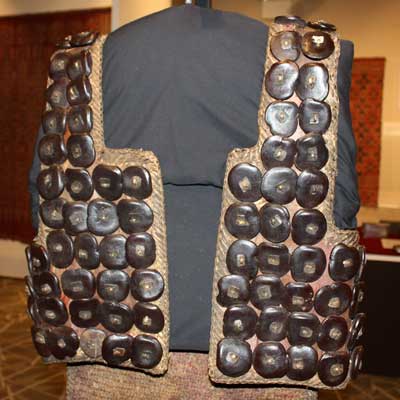
An armored vest from the Tana Toraja people of Sulawesi, Indonesia, is one of the featured items in the “Rarely Seen Southeast Asia” exhibit on display through May 15 at the NIU Anthropology Museum.
“Rarely Seen Southeast Asia: Art, Artifact, Ephemera,” an exhibition of more than 150 pieces curated by NIU professor emeritus Richard Cooler, will open today at The Anthropology Museum, with a public reception from 4 to 6 p.m. in Fay-Cooper Cole Hall.
Drawn from the museum’s collection and private sources, the exhibition celebrating the 50th anniversary of the Center for Southeast Asian Studies (CSEAS) is, in Cooler’s words, a “contemporary curiosity cabinet” containing sculptures, ceramics, textiles, rattan weavings, wood carvings, leather carvings, silver repousse work, mother-of-pearl inlay and paper ephemera.
As Cooler explains in an accompanying short video visitors may view while at the museum, most of the objects in the exhibit are rarely exhibited for reasons ranging from rarity to cultural taboos.
“Many pieces are finely made of beautiful materials, with some used for anachronistic pursuits such as head hunting, snaring song birds or chewing betel nut,” he said.
By displaying these rarely seen objects reflecting the culture of indigenous peoples and various ethnic groups now under pressure from globalization, Cooler said that he hopes to deepen people’s experience of Southeast Asia beyond Angkor Wat, Bali and other popular tourist destinations. “I don’t think these people and these objects should be forgotten because they’re being quickly eclipsed by international forces,” Cooler said.
Chewing betel (a seed from the areca palm), for example, used to be practiced by all levels of society in many Southeast Asian countries whereas today betel-chewing is considered an unhealthy habit like smoking and has fallen out of common use, he said. The exhibit includes a display of artfully designed betel boxes used to store the nut and ceramics decorated with illustrations of betel culture.
Some of the objects in the exhibit are so unusual, Cooler said, that he believes even seasoned Southeast Asia scholars might be surprised at some of them, pointing out such items as a Vietnam War-era Lao weaving that includes helicopters and guns among its motifs.

Professor emeritus and exhibit curator Richard Cooler with some of the objects on display at “Rarely Seen Southeast Asia,” opening Oct. 11 at The Anthropology Museum in Fay-Cooper Cole Hall.
An art historian whose love of collecting goes back to childhood, Cooler has worked tirelessly over the past year on the exhibit, collaborating with interim museum director Sara Pfannkuche and later with new director Jennifer Kirker-Priest, who arrived at NIU in mid-summer.
Although the museum officially opened in February, the basement storage facilities were not completed until recently, which meant there was no access to the collection temporarily in protective storage in the museum’s former space in the Stevens Building until just a few weeks ago.
It’s been a busy past few weeks getting the exhibit ready, Kirker-Priest said, but she is looking forward to having “Rarely Seen Southeast Asia” in house through the end of the academic year.
“This exhibition is particularly exciting for the Anthropology Museum because it promotes one of the real strengths of the permanent collection and the university which is Southeast Asia,” Kirker-Priest said. “Through the passion and scholarship of our guest curator, Richard Cooler … this exhibit offers something for everyone. From the artistic beauty of each piece to the story and cultural context behind each object, this is an exhibition that will spark interest in even the most casual visitor.”
All are welcome today to the exhibit opening, which will include light refreshments, a short performance by the NIU marching gamelan ensemble, led by School of Music professor Jui-Ching Wang, and a short program.
For hours or other information, call the museum at (815) 753-2520. The exhibit, which is co-sponsored by CSEAS and the Department of Anthropology, will close May 15.
